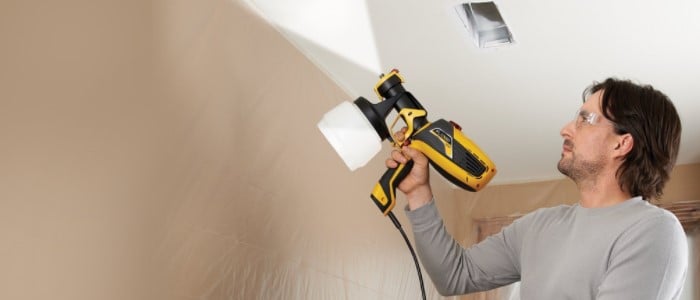Randy Charles is the owner of PaintCentric.com, a website dedicated to providing information, tips, tricks, and news about all things paint. With over 10 years...Read more
To paint trim with a spray gun, first, we need to do some prep.
- Remove all furniture, wallpaper, etc., from the room.
- Wear protective clothing and a dust mask for fumes.
- Cover walls, windows, etc., with plastic or drop cloths.
Then, prepare the surface. Patch any holes, and fill gaps with caulk. Now, we’re ready to start painting!

Gather all necessary supplies.
Gather all the necessary supplies and materials before using a spray gun to paint. It is key to having a successful paint job! You can find it challenging, but it gets easier and faster once you get the hang of it.
In general, you need the following:
- Oil-based enamel or latex paint for interior wood trim
- Tack cloth
- Extension cord and power strip
- Air hose (long enough to reach corners)
- Spray gun
- Colored primer or blocking primer (check local home supply shop)
- Pneumatic compressor (for larger projects, use a 2HP compressor)
- Drop cloths
- Safety goggles/glasses
- Masking tape and plastic sheeting, drop cloths or newspaper to protect walls and carpet.
Prepare the area to be painted.
Successful painting with a spray gun requires a proper preparation. Always take safety precautions and follow the gun manufacturer’s instructions.
- Ensure the surface is clean and dry, with no dust, dirt, or debris.
- Cover furniture and objects to avoid paint splatters.
- Scrape away old paint or varnish with a razor blade.
- Sand any blemishes or irregularities.
- Wipe down the surface to remove dust particles before painting.
- Allow each material layer to dry and cure before applying the next layer.

Choose a paint color.
Choosing the right paint color for the trim can be tricky. Think about the colors already in the room that you want to keep. Or if you have a certain design in mind. Look at how the trim is painted – it may match a current color or tone.
Consider how it will pair with wall and ceiling colors when deciding. Light walls usually need darker trims, and darker walls need light trims. Unless you’re looking for contrast. Once you’ve narrowed down your options, test swatches to find the perfect color. Make sure you buy enough paint for the project!
Set Up the Sprayer
Intimidating? Not anymore! With the correct info, painting trim with a spray gun can be a cinch! Prep your sprayer correctly to get the best results. Here’s how:
- Set up the spray gun for trim-painting projects.
That’s it!
Prepare the spray gun.
Spray painting trim correctly requires proper preparation and setup of the spray gun. Follow the manufacturer’s instructions for your particular model. Ensure all components are in place and working before spraying.
Start by having a clean, dry workspace. Clear it of anything that could clog the nozzle. Connect the air hose to your spray gun and compressor. Fill the paint cup and attach it to the gun. Check for air/paint pressure leaks.
Adjust the pressure settings from either source until you get the desired results. Secure all settings and connections before each project. This will ensure consistent results when spraying!
Select the right nozzle size.
Choosing the correct nozzle size is key for setting up your sprayer. ForSizestween 0.009″ and 0.016″ are normally used. A painting trim adjustable gun takes different sizes, while a single-gun setup requires a nozzle with multiple holes. Make sure to check the manufacturer’s guidelines before making the selection.
Apart from nozzle size, fan width and spray pattern shape must be adjusted depending on the paint and area of use. Fan width should be 8-1/4″ for interior wood trim and horizontal pattern. If you can’t find these details in the manual, look online or ask an expert at your local hardware shop or home improvement center.
Adjust the pressure
Turn on the compressor. Check the pressure gauge. The pressure depends on mist size. Look in the manual or ask a supplier for advice. To change pressure, turn the main or release valve. Wear protective gear. Move objects and cover surfaces. Now you’re ready to paint!
Applying the Paint
Spray painting trim is a great way to save time and get an even look. The steps are easy, no matter the material – railing, molding, etc. –. Here’s your guide to success! Plus, we’ll give you safety tips and advice on achieving a perfect finish.
Begin spraying at the top of the trim.

Before you paint, prepare the area. Open any windows or doors and cover anything you don’t want to paint with a cloth or painter’s tape. Now, set up your spray gun. Fill the cup 1/3 full with paint and stir it. Attach a filter/strainer and a nozzle tip. Place the can of paint close by. You’re now ready to spray.
- Start at the top, working across a wall section from left to right.
- Hold the gun handle and keep a 10-12″ distance from the trim surface.
- Overlap each stroke by 50% for smooth coat coverage.
Move the spray gun in a smooth, even motion.
Shake the spray gun for a few seconds. Hold the trigger and move it 10 inches away from the trim. Move it in parallel with the trim. Release the trigger once you’re done painting the area. Don’t pause or linger too long on one area. Spray lightly over each area two or three times to prevent runs.
Clean the equipment properly after use. Check the safety guidelines provided by the manufacturer:
- Shake the spray gun for a few seconds.
- Hold the trigger and move it 10 inches away from the trim.
- Move it in parallel with the trim.
- Release the trigger once you’re done painting the area.
- Don’t pause or linger too long on one area.
- Spray lightly over each area two or three times to prevent runs.
- Clean the equipment properly after use.
- Check the safety guidelines provided by the manufacturer.
Apply multiple coats of paint.
Before applying paint to the trim, prepare the surface. Clean it with a wire brush and a damp cloth. Also, sand down areas with major imperfections.
When the surface is debris-free, use a spray gun to apply multiple coats of paint. Spread each coat in slow overlapping motions. Allow each layer to dry before applying another coat. Choose fewer, thinner layers instead of thick ones. Thick layers can cause sagging or bubbling, ruining the look.
Finishing Up
Spray-painting your trim is a snap. But after you’ve finished, it’s key to spend time cleaning and caring for your spray gun. Here’s how to keep it in perfect condition:
- Disassemble the gun, being careful to keep all parts in order.
- Clean the gun with solvent and a lint-free cloth.
- Reassemble the gun, making sure all parts are securely fastened.
- Apply a light coat of oil to all moving parts.
- Store the gun in a dry place.
Remove the paint residue.
Once you’re done with the spray gun, it’s important to clean and store it properly. Remove any paint residue from the surface with a brush or a cloth soaked in a solvent cleaner like turpentine. Please don’t get any solvent into the chambers or filters; it may damage your equipment. Rinse off with water and dry with a lint-free cloth.
For more stubborn residue, disassemble your gun. Place the parts on a non-porous surface and use brushes and cleansers specifically made for paint guns. Make sure everything is dried before assembly. A flush cup can help remove caked-on messes. Shake gently after spraying each part and pat lightly with a shop towel.
Clean the spray gun
Are you finishing up your painting project? Be sure to clean your spray gun! Manufacturer instructions must be followed to guarantee a long life. Airless paint spray guns need attention before storage. Lack of maintenance can lead to clogs, extra materials used, and uneven coverage.
- Clear any leftovers from the internal and external components. Residue on the gun causes corrosion and clogs, limiting its future use.
- Inspect all parts for wear or damage. Replace any worn items with new ones that match the manufacturer’s specs.
- Clean the nozzle with a wire brush, then rinse with lacquer thinner or a similar solvent. Allow time for parts to dry. This prevents rust build-up while stored.
- Follow all safety requirements recommended by the solvent manufacturer.
Now you can confidently finish this project without worry!
Apply a clear coat of sealant.
Once the paint’s dry, a clear coat sealant is needed to protect the trim. Pick a glossy finish and use a spray gun for the best results. Open up a ventilated area, and don’t over-spray. Leave it alone ’til it’s completely dry.
Frequently Asked Questions
What kind of paint should I use with a spray gun?
The best paint to use with a spray gun is specifically designed for spray guns. This type of paint is usually latex or acrylic, designed to atomize properly in the spray gun, resulting in a smooth, even finish.
What kind of nozzle should I use on my spray gun?
The nozzle you use will depend on your type and the type you’re trying to achieve. Generally, a larger nozzle is better for thicker paints, and a smaller nozzle is better for thinner paints. You may also want to consider a nozzle with a fan-shaped spray pattern for more even coverage.
What surface should I use to paint trim with a spray gun?
Before you begin painting, you’ll want to ensure the surface is properly prepared. If you’re painting wood, ensure it’s been sanded and primed. If you’re painting metal, make sure it’s been cleaned and lightly sanded. Once you’ve prepared the surface, you’re ready to begin painting.

Randy Charles is the owner of PaintCentric.com, a website dedicated to providing information, tips, tricks, and news about all things paint. With over 10 years of experience in the painting industry, Randy has become an expert in the field and is passionate about helping others learn more about painting. He has written numerous articles on the subject and is committed to providing accurate and up-to-date information to his readers.
- Latest Posts by Randy Charles
-
Can you Paint a Bathtub? – Here Is Your Answer
- -
How to Paint Furniture? – Learn Now
- -
How much does it Cost to Paint a House? – Find Out Here
- All Posts
